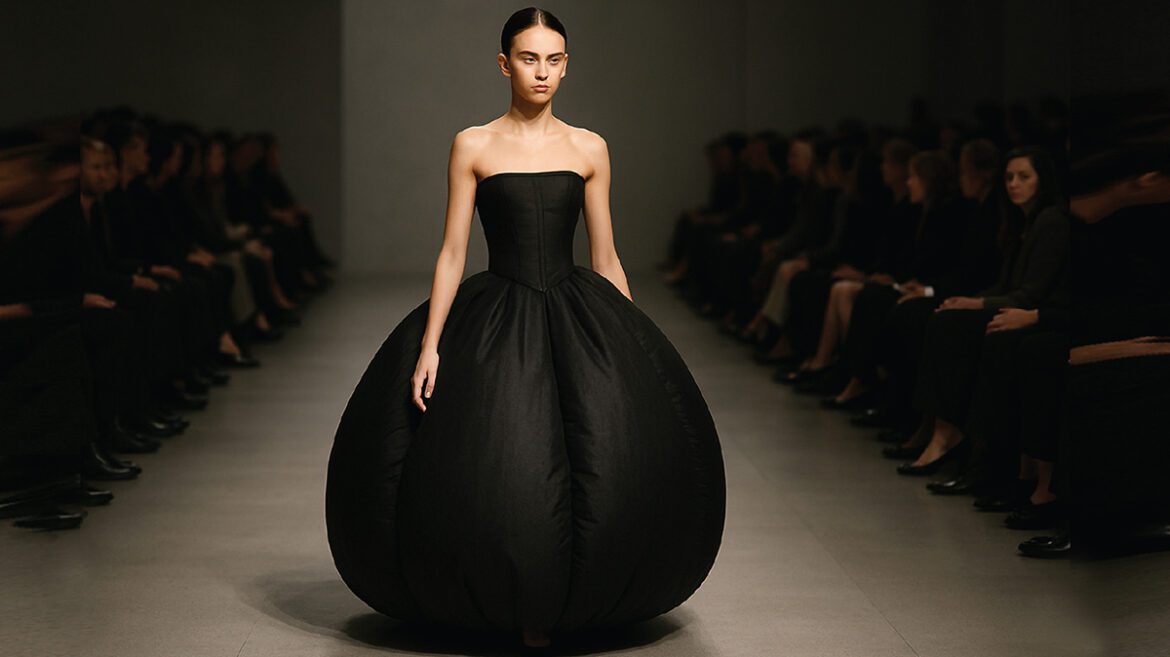Inflatable fashion is redefining silhouettes with a dramatic burst of air—quite literally. Designers like Jack Irving, HARRI, and Fredrik Tjærandsen are expanding the boundaries of couture with garments that inflate and contract on demand, turning clothing into performance and sculpture.
The origins of inflatable couture can be traced back to the postmodern art movements of the 1960s and 70s, when avant-garde artists began experimenting with air as both material and metaphor. Visionaries like Christo and Jeanne-Claude explored inflatables in environmental art, while fashion provocateurs used vinyl and latex to challenge the permanence and structure of traditional clothing. Inflatables introduced a new language—one of impermanence, transformation, and spectacle. The idea that clothing could change shape, size, or state with a single breath was both futuristic and deeply human. Designers today build on that legacy, using air not just for volume, but to ask deeper questions: What if fashion could be momentary? What if it could breathe, morph, and vanish?
British designer Jack Irving, acclaimed for dressing icons like Lady Gaga and Paris Hilton, debuted a bold inflatable collection titled Quixotic at London Fashion Week. Made for the On|Off showcase, these pieces were part clothing, part creature: tentacle-like shapes inflated around models’ bodies, evoking deep-sea lifeforms that pulsated and shifted with each step. Irving’s vision transforms air into wearable drama, a spectacle that demands attention and reimagines the canvas of fashion itself.
Meanwhile, HARRI (Harikrishnan Keezhathil Surendran Pillai) has elevated inflatable design to new heights. First emerging during his MA at the London College of Fashion, where he created gravity-defying latex balloon trousers, HARRI has since developed a signature aesthetic of exaggerated forms and sculptural proportions. His inflatable suits—noticeably worn by Sam Smith at the 2023 Brit Awards—feature oversized shoulders, bloated trousers, and bulbous silhouettes that merge tailoring with inflated architecture. HARRI’s work blends performance, craftsmanship, and latex farming (he cultivates his own material in India), elevating the inflatable medium into an art form.
The narrative reaches its most experimental incarnation in the work of Fredrik Tjærandsen, a Norwegian graduate of Central Saint Martins whose 2019 show stunned the fashion world. His collection Moments of Clarity sent models down the runway encased in massive, oxygen-filled latex bubbles—only to have them deflate mid-walk, transforming into dresses and skirts in real time. Each inflatable torus was crafted with minimal seams, using sustainably sourced Sri Lankan rubber, and featured an internal latch system allowing wearers to control deflation and reveal the garment within. The theatrical moment became viral, earning Tjærandsen the L’Oréal Professional Young Talent Award and admiration from celebrities and fashion editors alike.
What makes inflatable fashion so compelling is its elegant paradox: the illusion of weightlessness paired with visual enormity. These garments reframe air not as emptiness but as substance—material that sculpts the body and space around it. Inflated forms challenge traditional tailoring, exaggerating proportion and altering perspective, whether tethered to high art or street spectacle. Above all, inflatable fashion instills a playful dynamism—a puff of air and the silhouette morphs, revealing form, color, and narrative all in a single breath.
From Jack Irving’s tentacled inflatables, to HARRI’s latex architecture and Fredrik Tjærandsen’s deflating balloon dresses, inflatable fashion is more than trend—it is transformation. It blows open space, reshapes shape, and deflates expectation.

